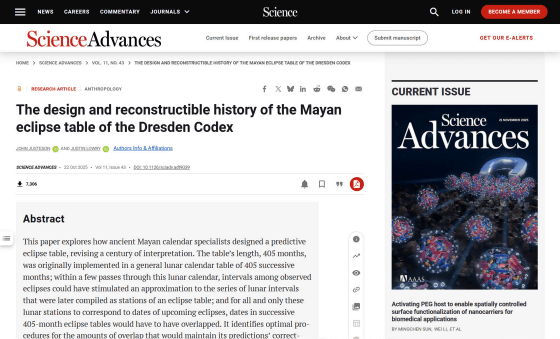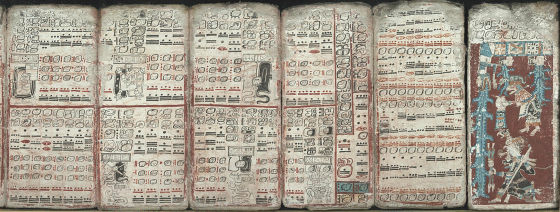Reveals how the Mayan civilization used 'tables predicting solar eclipses'

The design and reconstructible history of the Mayan eclipse table of the Dresden Codex | Science Advances
https://www.science.org/doi/10.1126/sciadv.adt9039

Scientists Reveal How The Maya Predicted Eclipses For Centuries : ScienceAlert
https://www.sciencealert.com/scientists-reveal-how-the-maya-predicted-eclipses-for-centuries
The Maya civilization, which existed in what is now southeastern Mexico and Guatemala, used calendars to predict important astronomical events for over 2,000 years, even before the European conquest of the Americas. However, most of the documents that recorded this knowledge were destroyed by the Spanish Inquisition , and very few remain today.
One of the few remaining documents from the Maya civilization is the Dresden Codex , a 78-page accordion-fold document believed to date from the 13th to 14th centuries. It is believed to be a copy of a document written in the 11th or 12th century.
Each page of the Dresden Codex is brightly illustrated and contains Maya inscriptions detailing astronomy, astrology, seasons, medicine, and rituals, including tables for predicting solar eclipses.
For the Maya civilization, which was built and operated around astronomical phenomena, predicting solar eclipses was an important task. Kimberly Breuer, a historian at the University of Texas, explains, 'By recording what happened during a particular celestial event, the Maya could receive advance warning and take appropriate precautions when the cycle repeated. Priests and rulers would have known how to act, what rituals to perform, and what sacrifices to make to their gods to ensure the cycle of destruction, rebirth, and renewal continued.'

by Wikimedia Commons
The solar eclipse table in the Dresden Codex spans 405 lunar months, or roughly 11,960 days, from the base date to
'If you start from the end of the table and create the next one, you may encounter unexpected eclipses when applying the next one, and this happens more and more frequently with each reset,' said John Justeson , a linguist at the University of Albany in the US, and Justin Rowley, an archaeologist at the University of New York at Plattsburgh in the US.
Instead of starting over at the end of the table, Justeson and his colleagues propose starting a new table at the 358th or 223rd month of the table. This approach allows for much more accurate prediction of solar eclipses.
Cross-checking this method against modern solar eclipse cycles confirmed that the Maya were able to accurately predict all solar eclipses visible in their territory between 350 and 1150 AD. 'With this revision, the table remains valid indefinitely, with an error of just under 51 minutes over 134 years,' Justeson and his colleagues wrote.

Related Posts:
in Science, Posted by log1h_ik







